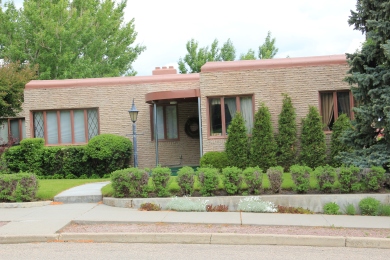 Toole County, second day: As I ventured out from Shelby into Toole County in February 1984 I followed old US Hwy 91 route (surpassed then as now by I-15) into an early 20th century oil patch region–the Kevin-Sunburst field–that had been discovered in the 1920s during Montana’s initial oil boom, but had dried up until the 1950s, although limited production remains even today. In 1984 everyone in Helena thought that I should give the region a look for early resources associated with the oil industry.
Toole County, second day: As I ventured out from Shelby into Toole County in February 1984 I followed old US Hwy 91 route (surpassed then as now by I-15) into an early 20th century oil patch region–the Kevin-Sunburst field–that had been discovered in the 1920s during Montana’s initial oil boom, but had dried up until the 1950s, although limited production remains even today. In 1984 everyone in Helena thought that I should give the region a look for early resources associated with the oil industry.
Oilmont school had closed already in 1984 but the hipped roof frame building remained as a symbol of the boom days. Thirty years later, I was surprised to see, the school was still there, barely–the years had not been kind to it. Jerry Funk in his memoir, “Life is an Excellent Adventure,” recalled that “The school plant itself was an ungainly hodge-podge of after-thoughts and additions and mismatched free-standing structures. Its construction was obviously undertaken, with boom-town gusto and elan, as and when new space was needed, without the constraints of dealing with architects and planners. The result was perhaps not what one would call pretty, but it was quite serviceable, and certainly memorable.”
 Better stories in 2013 awaited me in Kevin, to the west. Here the historic Kevin depot, which is listed in the National Register, had been moved off the tracks, but it had been converted to a community center and senior citizens center, a very appropriate and successful adaptive reuse. The town numbers under 200 residents and their commitment to keeping this connection to the town’s railroad roots along this spur line alive and well is commendable.
Better stories in 2013 awaited me in Kevin, to the west. Here the historic Kevin depot, which is listed in the National Register, had been moved off the tracks, but it had been converted to a community center and senior citizens center, a very appropriate and successful adaptive reuse. The town numbers under 200 residents and their commitment to keeping this connection to the town’s railroad roots along this spur line alive and well is commendable.
Also in Kevin in 1984 a circa 1930 service station caught my eye, with especially the period “Firestone” signs.  Rather amazingly the building still stands at the town’s prominent corner, although the roof is sagging and its original function is more difficult to discern today.
Rather amazingly the building still stands at the town’s prominent corner, although the roof is sagging and its original function is more difficult to discern today.
Another favorite building in 1984 was the Derrick Bar, a friendly place where the very name spoke to what was happening in Kevin in the mid-20th century. Its miniature derrick sign, on the top of the building, was a beacon; unlike anything else I would see in Montana.
The bar is still there–still friendly too–but the derrick had come off of the top–although it too was preserved on the side of the building.
Kevin-Oilmont was a section of Toole County that had promised untold wealth in the 1920s and 1930s–and the boom at the Kevin-Sunburst field helps to explain the strong imprint of 1930s modernism in Shelby.
The most important Jazz Age building in Shelby is the visitor center, from 1923. Listed in the National Register, the building served as the local headquarters for the city’s ambitious attempt to host a world’s heavyweight fight between legendary boxer Jack Dempsey and Tommy Gibbons. Flush with oil money, town boosters thought the fight would put Shelby on the map, but the projected tens of thousands of spectators never materialized–only 7,000 made it to Shelby–and the event bankrupted the town.
At the western end of the historic downtown is another National Register landmark, the Rainbow Service Station. The development of U.S. 2 as the region’s key east-west automobile/truck corridor happened at the same time as the oil boom, and as auto travel to Glacier National Park also was growing in numbers.
In between these two landmarks grew an impressive collection of commercial buildings, along with some of the best roadside neon in the state. Modernism isn’t confined to the commercial strip. There are impressive residential designs of International Style and Art Deco from the 1930s.
And both the New Deal Art Deco high school (now middle school) and the contemporary-styled St. William Catholic School make their own statements of mid-century modern architecture.
Shelby might be a modern urban oasis on the Hi-Line but as soon as I started to move east of the visitor center along U.S. 2 I discovered that I was entering a very rural, agricultural landscape: more on that later.













